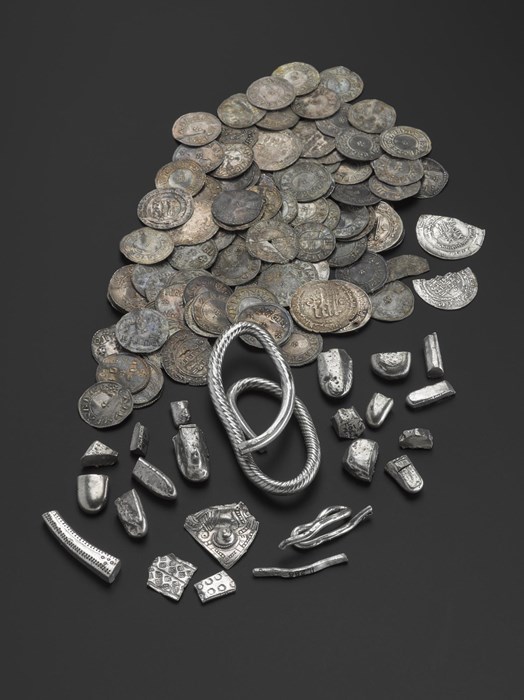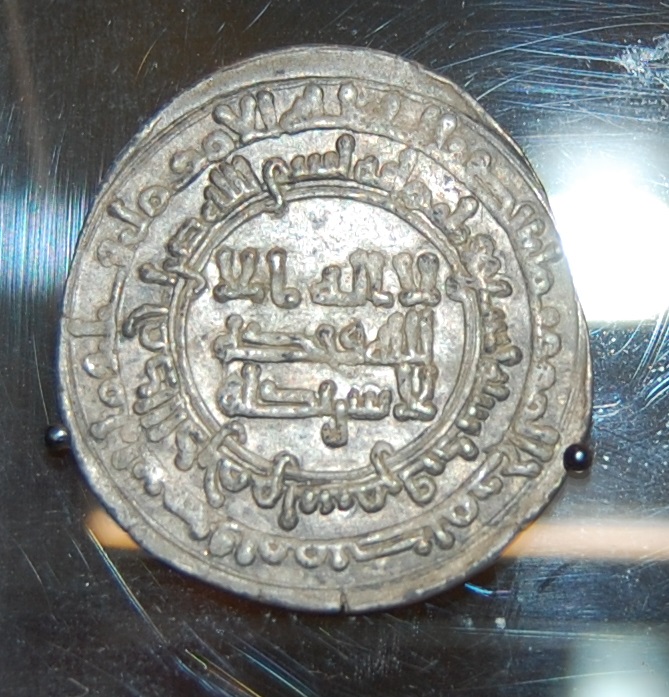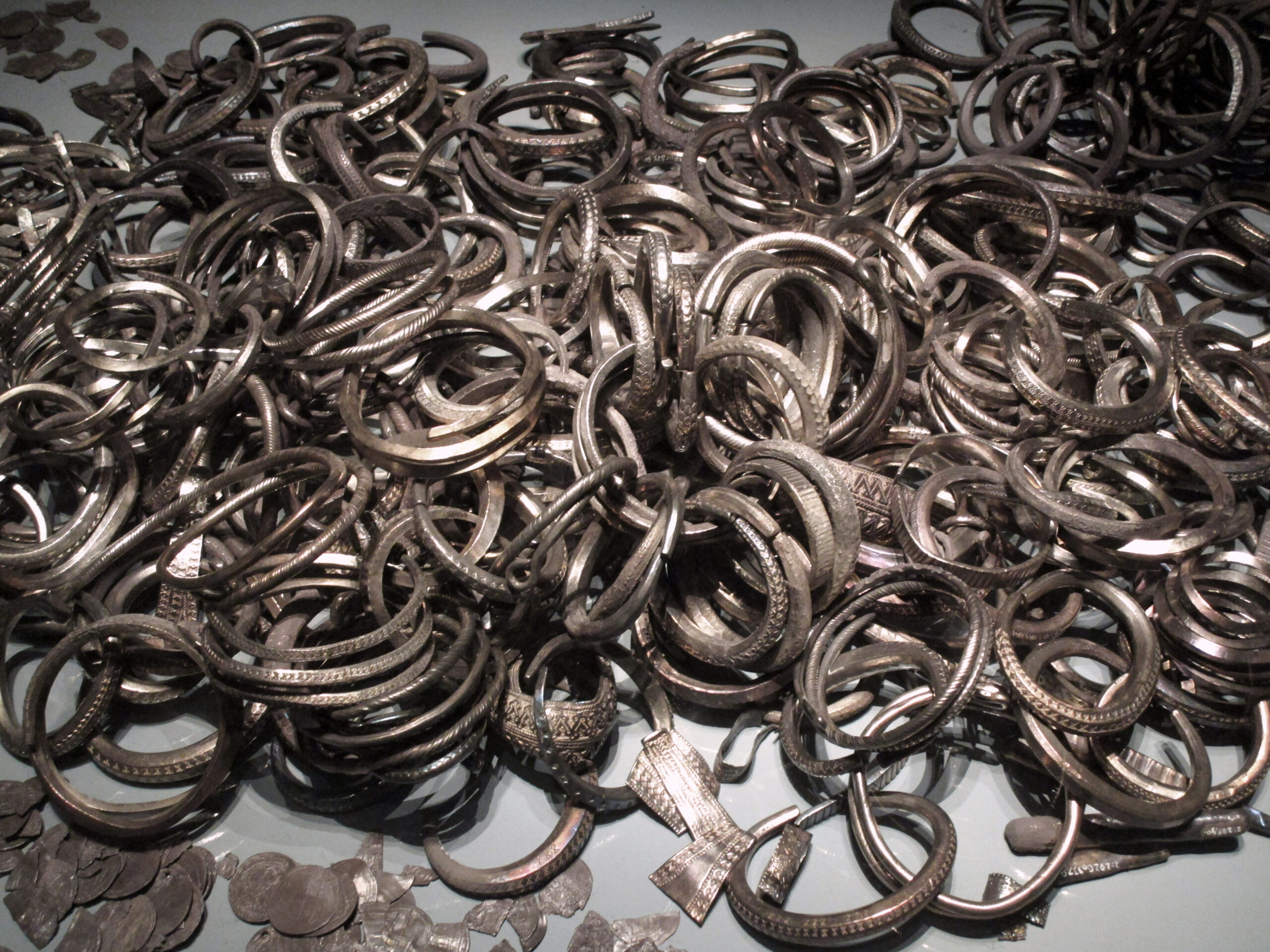Although many may not know, silver dirhams originating in the Islamic world are one of the most prominent finds in Viking hoards. I want to focus on a particular hoard found at Storr Rock on the Isle of Skye in modern Scotland, one of the places furthest away from the medieval Islamic world where archaeologists have found these coins.1 These coins were not the only items found in the Storr Rock Viking Hoard, which contained many other silver items and silver coins from other places such as further south in Britain, but they comprised a significant portion of the findings. As did many in the medieval and ancient world, contain the names of the rulers they were minted under. Based on this, we can date these coins’ minting to around 895–942 CE. We can also determine that they were produced under the Samanid emirate, which existed in Central Asia from roughly the ninth to eleventh centuries CE.

The Storr Rock Hoard
110 silver coins and 23 other fragments.
(source: National Museums Scotland)
The coins are all incredibly consistent, sharing the same key features, including Qurʾānic verses, the name of the ruler the coin was minted under, and the date of minting. The coins found at the Storr Rock Viking Hoard were specifically produced under three Samanid rulers. As noted by the National Museum of Scotland, there are to be found within the hoard “5 coins of Ismai’il bin Ahmad (r. 892-907), 4 coins of Ahmad bin Isma’il (r. 907-914), and 9 coins of Nasr II bin Ahmad (r. 914-943).” Furthermore, they note that most dirhams found in medieval Northern Europe come from the Samanid emirate during the rule of these three emirs, who were the first three rulers of the emirate.
Like all Islamic coins from the eighth century CE onward, there are no depictions of any person. This makes it so that the main feature of these coins is exclusively the Arabic script. While a coin depicting some kind of humanoid figure would’ve been understood by the Vikings to be a person, I am unsure if they registered the Arabic script on the coins as writing or as intricate designs, especially considering that these Samanid coins seem to alternate fonts, with the more traditional Kufic script in the center and the, at the time, newly-emerging Naskh script around the sides.

Dirham of Nasr II bin Ahmad from the British Museum collections.
Samarkand, 921 (AH 309).
Silver, 3.5 g.
(source: BM)
Kovalev and Kaelin argue in their article on the paths taken by Arab silver (which I feel should better be labeled Islamic silver as, although it’s still not wholly accurate, most of the silver in Northern Europe, as mentioned earlier, is of Samanid origin who were Persianate rather than Arab) across Afro-Eurasia that the reason that the majority of silver originating in the Muslim world was found in northern Europe was that northern Europe was particularly silver-scarce and also had an abundance of furs and slaves, both in high demand in the Muslim world, to trade for the silver.2 Kovalev and Kaelin utilized lists cataloging all known hordes of silver from the Muslim world across Afro-Eurasia to determine the frequency of findings in specific locations. By crunching the numbers like this, a clearer map emerged of the intensity of trade between the Islamic world and its neighbors, pointing to the fact that there was a particularly strong trade connection between the Samanids and northern Europe to the extent that the authors believe that the Samanids may have struck as much silver as they did specifically with the trade with northern Europe in mind. The authors seek an explanation for this using Arabic chronicles’ mention of changing fashion, the impact of a plague on the labor force, and the significant numbers of slaves in the Abbasid court to determine that trade with northern Europe was also strongly coveted in the Islamic world specifically for furs and slaves.
Kovalev and Kaelin help us understand why silver dirhams such as the one found on the Isle of Skye were so common and reached such disparate places. The intense quantities of Samanid dirhams making their way into northern Europe were so much so that their presence and importance to the Vikings is reflected well outside of Scandinavia and Eastern Europe, where trade would’ve been strongest, in this case into the British Isles. This suggests a critical role the Vikings had in connecting world regions. In the absence of direct trade between the British Isles and the Islamic world, the Vikings helped bridge the gap and play their role in establishing an increasingly connected and globalized medieval world system, carrying Central Asian silver into the far end of Western Europe, that modern scholars are only now slowly beginning to understand and appreciate.

Select artifacts from the Spillings Hoard, SE.
Silver arm rings, coins, and fragments.
(source: Wikimedia)
How did the Vikings themselves perceive these dirhams, however? We know that these coins were not the only items to be buried as part of the Storr Rock Viking Hoard. As mentioned previously, they were buried alongside a variety of items and coins united only in the fact that they were silver. This suggests that the value found value in these Samanid dirhams specifically for their silver composition and that they were fungible with other silver items. In fact, the Vikings don’t seem to have used these dirhams as coins at all. Instead, once these coins arrived in the Viking world, they were used chiefly as jewelry. Did the Vikings recognize that they were trading their furs and slaves for silver coins then, or did they recognize these objects as not more than oddly-minted silver bullion to be reshaped and reused however one saw fit? The process of entering the Viking World, thus, seems to have been a transformative process for these coins. One could argue that by the sharp change in their manner of usage, they became different objects altogether. While there is often discussion on how transformative the Viking Age was in the history of the people living in Scandinavia, the British Isles, or the north of Mainland Europe, I think it is worth considering how the Viking Age was a transformative process for objects as well, particularly considering the sheer amount of dirhams, for example, that were imported into Scandinavia and totally repurposed. Furthermore, the change in these dirhams’ nature helps us better understand that trader networks have varying significances for the people involved in them. While the Samanids exchanging currency for furs and slaves may have seen such interaction as a purchase, the Vikings may have seen the same interaction as barter, exchanging furs and slaves for silver.
1 National Museums Scotland, “Silver Dirhams from the Storr Rock Viking Hoard,” https://www.nms.ac.uk/explore-our-collections/stories/scottish-history-and-archaeology/storr-rock-viking-hoard/.
2 Roman K. Kovalev and Alexis C. Kaelin, “Circulation of Arab Silver in Medieval Afro-Eurasia: Preliminary Observations,” History Compass 5 (2007): 1–21.
« Previous | Home | Next »